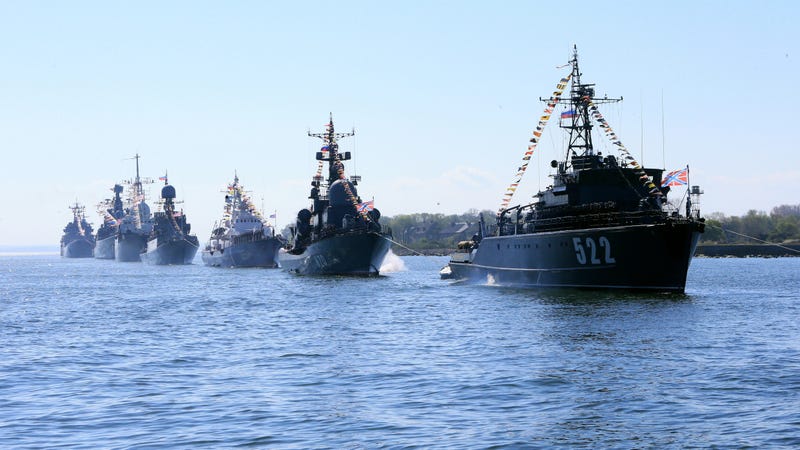
 Foxtrot AlphaTech and news from the world of modern defense.
Foxtrot AlphaTech and news from the world of modern defense.The Russian Navy is in trouble. After years of coasting on the largesse of the Cold War, Russia’s navy is set to tumble in size and relevance over the next two decades. Older ships and equipment produced for the once-mighty Soviet Navy are wearing out and the country can’t afford to replace them.
As U.S.-Russian relations continue to decline, it’s a good time to look at an arm of the Russian military in control of a hundreds nuclear weapons, most of which can strike the United States within minutes.
At the end of the Cold War, Russia, the largest of the ex-Soviet republics, inherited the lion’s share of the USSR’s military equipment. Among naval forces this included several Kiev and Riga-class aircraft carriers, Kirov-class nuclear powered battlecruisers, destroyers, frigates, and more than two hundred submarines—including the enormous Akula-class ballistic missile submarines. Russia, struggling to switch from a planned to market economy, could not afford to maintain such a truly massive force and scrapped much of it, preserving only the newest equipment.

Russia’s economy, flat on its back for more than a decade, started to claw back in the mid-2000s, thanks in large part to spiking oil prices. Today Russia is the fourth largest spender on defense worldwide. In 2017, the earliest year in which comparisons are possible, Russia’s gross domestic product amounted to $1.5 trillion dollars, of which it spent 4.3 percent on defense. That works out to $66.3 billion for Moscow’s war machine, trailing only the United States, China, and Saudi Arabia (yes, Saudi Arabia spends more on defense than Russia).
Advertisement
Although Russia relies on conscription, lowering personnel costs, the defense budget still has to be divided between the army, air force, navy, and the country’s nuclear deterrent.
Today, 28 years after the end of the Soviet Union, Russia still relies mostly on Soviet-era ships. The country’s sole aircraft carrier, the Admiral Kuznetsov, has suffered from repeated mechanical problems and should be, but probably won’t be, retired immediately. Russia has built no cruisers since 1991, relying on the five impressive-but-aging Kirov and Slava-class cruisers to act as the country’s major surface combatants. Russia has built only one destroyer since the Cold War, the Admiral Chabanenko. Chabanenko was laid down in 1989 and commissioned into service in 1999.
Advertisement
Likewise, most of Russia’s submarine fleet still consists of Soviet-era submarines, includingDelta-class ballistic missile submarines, Oscar–class cruise missile submarines, and Akula, Sierra, Victor, and Kilo-class attack submarines, which have been in service for so long they are still referred to by the code names they were given in Soviet service.

Russia has traditionally been a land power throughout its history, but the Soviet Union’s rivalry with the United States required a big fleet to challenge the U.S. Navy, physically connect with the USSR’s communist allies abroad, and protect the country’s nuclear-armed submarine fleet.
Advertisement
The Soviet Navy accomplished all three to varying degrees, but today those accomplishments are a distant memory. Russia has clearly abandoned any pretense of keeping up with the U.S. Navy and struggles to send an aging fleet to aid Moscow’s allies (such as Syria) all while protecting its seagoing nuclear deterrent.
Russia’s naval decline isn’t just a matter of fewer warships but a decline of industry and infrastructure. Russia can’t even build large engines for warships: as Reuters points out, several Russian warships under construction are currently sitting high and dry because they are waiting on gas turbine engines ordered from Ukraine, which was made a bit more complicated after Russia invaded the place. The war between the two countries means it could be years before those ships can hit the water. In late 2018 the Japanese-built floating dry dock PD-50 sank as the Admiral Kuznetsov departed it, leaving Russia without a place to work on large warships.

Advertisement
Russia is concentrating its naval resources on mission number three, protecting its submarine-based nuclear deterrent. Moscow’s submarine-launched nuclear weapons are the country’s ultimate deterrent against nuclear attack, and arms control experts believe that as of 2018 the Russian Navy has 810 nuclear weapons under its control. Russia has spent a considerable amount of money keeping its submarine-based deterrent viable, developing the Bulava nuclear missile and the new Borei-class ballistic missile submarines. Even still, the aging out of ex-Soviet submarines means by 2030 Russia is expected to field only half the number of missile submarines it does now.
Russia’s spending on surface ships has been limited to small but heavily-armed frigates, corvettes and patrol boats designed for coastal missions. Russia has made repeated claims it will build an impressive number of new warships, chief among which are the Project 23000E “Storm” nuclear-powered supercarrier and Lider-class nuclear-powered guided missile destroyers. Both are allegedly in the design and development stage, but it’s difficult to see how, without a huge boost in military spending (and the know-how to build its own ship turbines), Russia could build a meaningful number of these ships.

Advertisement
Despite all of this, the Russian Navy will still be a force to be reckoned with. Russia’s ballistic missile submarines will each carry scores of long range nuclear weapons. Russia is poised to build 32 new Poseidon nuclear torpedoes to devastate the coastlines of enemies. The country is building a mixture of new high-end Yasen-class cruise missile submarines for the open ocean and low-end diesel electric submarines for operating in nearby waters. Both could be armed with nuclear-tipped cruise missiles and the new Zircon hypersonic missile system.
Russia will probably never again have the naval might of the Soviet Union, which NATO and many of Russia’s other neighbors would probably agree is a good thing. As the battlecruisers and aircraft carriers age out Russia will slowly transition from an global expeditionary naval force to one with only regional reach.
The Russian Navy of the future will look very different than the one sailing today.















